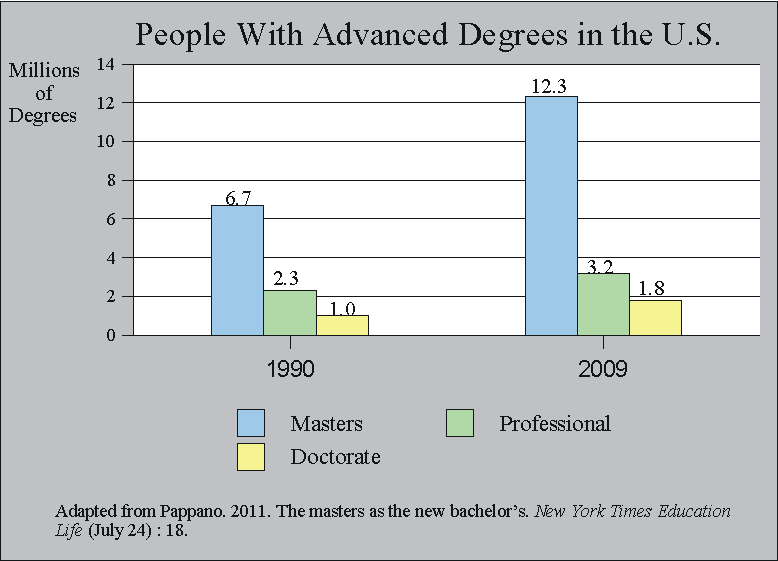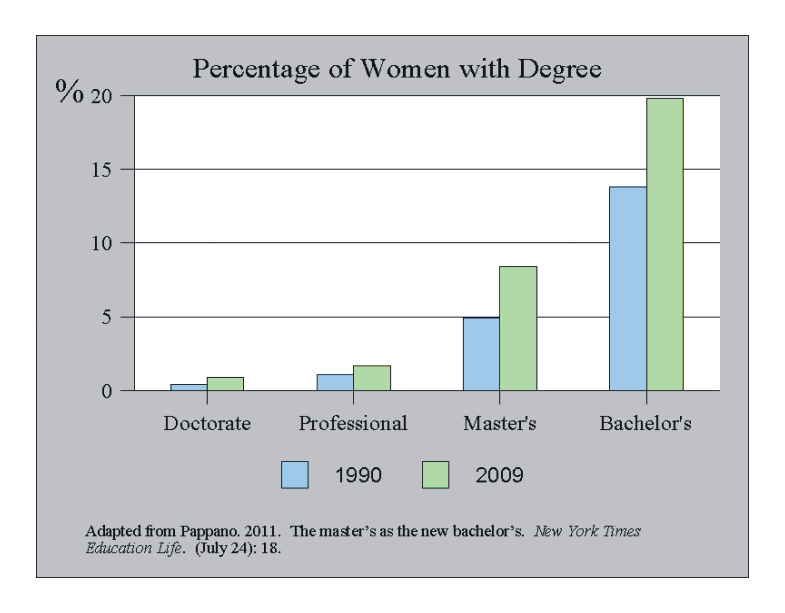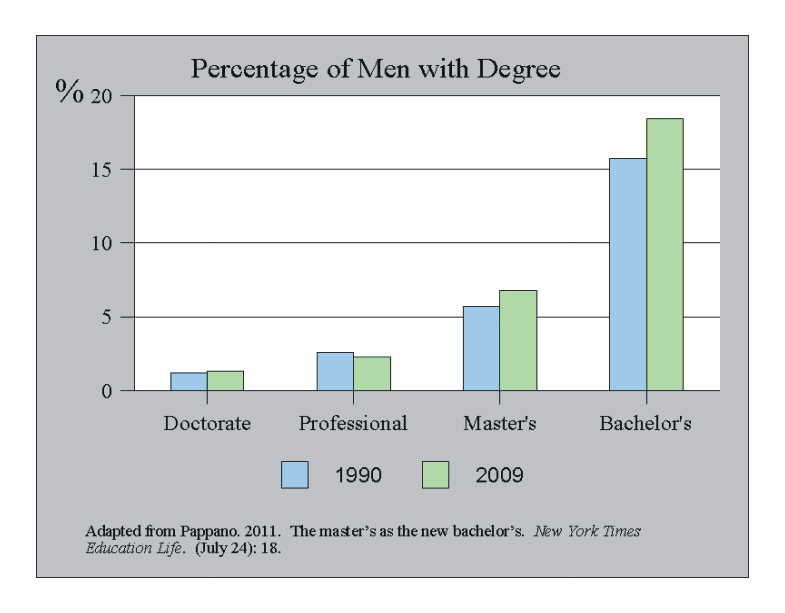
Summary by James R. Martin, Ph.D., CMA
Professor Emeritus, University of South Florida
Education Issues Main
| How to Manage Yourself Main
The purpose of this paper is to discuss some growth trends in graduate education and to provide some statistics to show the changes over the period from 1990 to 2009. The general trend discussed by Pappanno might be referred to as "credentials inflation". As indicated in the table below, masters degrees practically doubled over the last twenty years and by 2009 nearly eight percent of people age 25 and older had a masters degree. That's about the same proportion as those who had bachelors degrees or higher in 1960.

One relatively new and currently popular master's degree is the professional science master's or P.S.M.. The idea is to combine job-specific training with business skills. Pappano points out that a bachelors degree is no longer an adequate screening measure for employers. Colleges are producing more college graduates than the market demands and a master's degree is needed to stand out in the crowd. Given two otherwise equal job applicants, the one with the master's degree gets the interview. On the other hand, there are millions of job vacancies, but they don't tend to match up with the available talent. The P.S.M. degree is designed to alleviate that problem by matching the students degree program with the needs of potential employers.
Another interesting statistic is the growth in the number of women who are obtaining bachelor's degrees as well as graduate degrees. In 1990 only 13.8% of U.S. women age 25 to 64 had a bachelor's degree. That percentage had increased to 19.8% by 2009. Master's degrees for women increased from 4.9% in 1990 to 8.4% in 2009. Those statistics are illustrated in the table below.

There was considerably less growth for men as indicated in the following table. In 1990 only 15.7% of U.S. men age 25 to 64 had a bachelor's degree. That percentage had increased to 18.4% by 2009. Master's degrees for men increased from 5.7% in 1990 to 6.8% in 2009. Women seem to be gaining on men, particularly in the area of master's degrees based on the two tables above and below. However, a lot of the gains came from an increase in master's degrees in education.1

The following table shows a breakdown of occupations for women and men with advanced degrees. Women are heavily clustered in the teaching professions with relatively low pay compared to men who are more often employed in management positions. In 2009 women with master's degrees made 72 cents for every dollar made by men.
| Occupations of those with advanced degrees* | |||
| Women | Men | ||
| Primary school teachers | 1,402,000 | Managers and administrators | 713,000 |
| Subject teachers (high school, college) | 484,000 | Lawyers | 654,000 |
| Lawyers | 366,000 | Physicians | 501,000 |
| Managers and administrators | 319,000 | Subject teachers (high school, college) | 485,000 |
| Registered nurses | 303,000 | Primary school teachers | 368,000 |
| Mangers in education and related fields | 287,000 | Computer software developers | 292,000 |
| Physicians | 280,000 | Computer scientists and systems analysts | 221,000 |
| Secondary school teachers | 275,000 | Accountants and auditors | 218,000 |
| Vocational and educational counselors | 260,000 | Chief executives and public administrators | 216,000 |
| Social workers | 218,000 | Managers in education and related fields | 205,000 |
| * Adapted from Pappano. 2011. The master's as the new bachelor's. New York Times Education Life (July 24): 18. The Census Bureau, Minnesota Population Center, Institute of International Education, and Department of Education were cited as sources for the data in this table. | |||
The message indicated by the data reported in this article is that an advanced degree is more important than ever for job applicants even though most jobs do not require an advanced degree. While students are accumulating more debt, the beneficiaries of this development are colleges and employers. Employers can hire people with more training that they don't have to pay for. For colleges, master's degree programs are "cash cows".
Pappano ends the article with the question, "Will the Ph.D. become the new master's". I doubt that, since Ph.D. students are much more high maintenance and require a different type of faculty, i.e., those with research skills that most faculty do not have.
___________________________________________
1 Data collected by the National Center for Education Statistics indicate that 52 percent of kindergarten through 8th grade teachers have a master's degree or higher. In 2008 and 2009 there were 178,564 master's degrees in education awarded in the U.S., and that accounted for 27% of all master's degrees awarded. See Otterman, S. 2011. Pedagogical Puzzle: New model for teacher preparation think outside the box. Are they too far out? The New York Times Education Life (July 24): 24.
Related summaries:
Kamenetz, A. 2009. Who needs Harvard? Free online courses, Wiki universities, Facebook-style tutoring networks - American higher education is being transformed by a cadre of web-savvy edupunks. Fast Company (September): 84-89. (Summary).
Martin, J. R. Not dated. The accounting doctoral shortage and opportunities to teach accounting. Management And Accounting Web. AccountingDoctoralShortage.htm
Martin, J. R. 2015. IMA Salary Calculators 2010-2015. Management And Accounting Web. SumSalarySurveys.htm
Martin, J. R. 2016. AACSB International 2013 and 2016. 2012-2013 and 2015-2016 Salary Survey Reports: Executive Summary. AACSB. Management And Accounting Web. AACSB2013SalaryReports.htm
Simon, C. C. 2011. R.O.I.: Is graduate school worth the investment? The New York Times Education Life (July 24): 18-19. (Summary).
Schiffel, L., K. A. Smith and D. L. Schroeder. 2011. IMA 2010 salary survey: How's that recovery workin' for you? Strategic Finance (June): 26-46. (Summary).